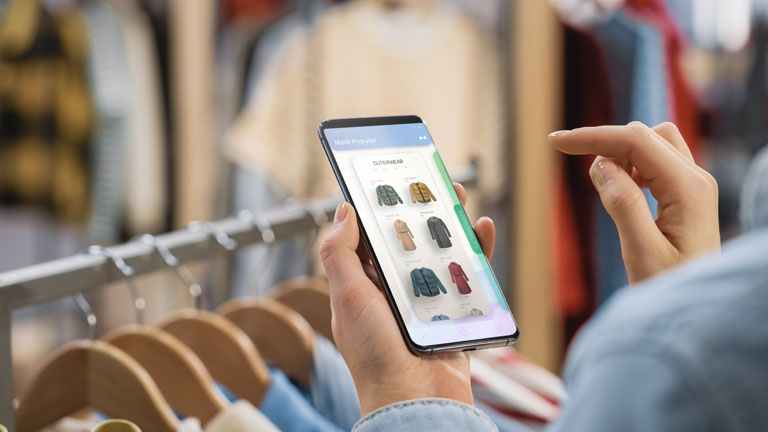Interacting with recommendation systems has become an integral part of our daily lives, whether shopping on Amazon or discovering new music on Spotify. These algorithms work silently in the background, guiding us towards our next favorite choices.
Yet, businesses relying on these recommendation systems to drive revenue have an obstacle: the cold start problem.
Picture a scenario where a customer makes their first purchase, or a new item is introduced without historical sales data—this poses a daunting task for conventional recommendation algorithms.
This blog will discuss the fundamental challenges marketers encounter with recommendation systems and show how customer genomes can be a solution.
Understanding the cold start problem in recommendation systems
The goal of any recommendation system is to predict what a customer might want to buy and showcase those products to guide their purchasing decisions. The algorithm analyzes customer behavior and product characteristics to estimate the likelihood that a customer will be interested in a specific item. It involves creating detailed profiles for each customer and product. This approach is useful when figuring out what products a customer might want to buy again.
Imagine a new customer making their first purchase on an e-commerce platform. This customer’s profile is essentially a blank slate. This is where the Cold Start Problem emerges. It occurs when there is limited or sparse data of these newcomers.
Traditional recommendation systems, including popular methods like content-based and collaborative filtering, heavily rely on historical behavioral data to generate recommendations.
The failure of these traditional recommendation systems means missed opportunities to engage with and cater to new customers effectively. Without accurate recommendations, new customers may feel less connected to the brand or may not discover the full range of offerings, potentially leading to lower retention rates and reduced customer satisfaction.
Check out this blog to learn more about different types of recommendation systems.
Now, let’s try solving the cold start problem in recommendation systems!
The ‘cold start’ issue intensifies with a growing customer base and expanding product inventory. Visualize a vast matrix where rows represent customers and columns represent products. This matrix becomes really large and complex to manage as more customers join and products are added. Now, dealing with such massive data requires a lot of computing power and resources.
The matrix is also quite empty in many places. This happens because not every customer buys every product, leading to uneven activity. So, it’s tough for the system to figure out what products to recommend when there are so many empty spots in the matrix.
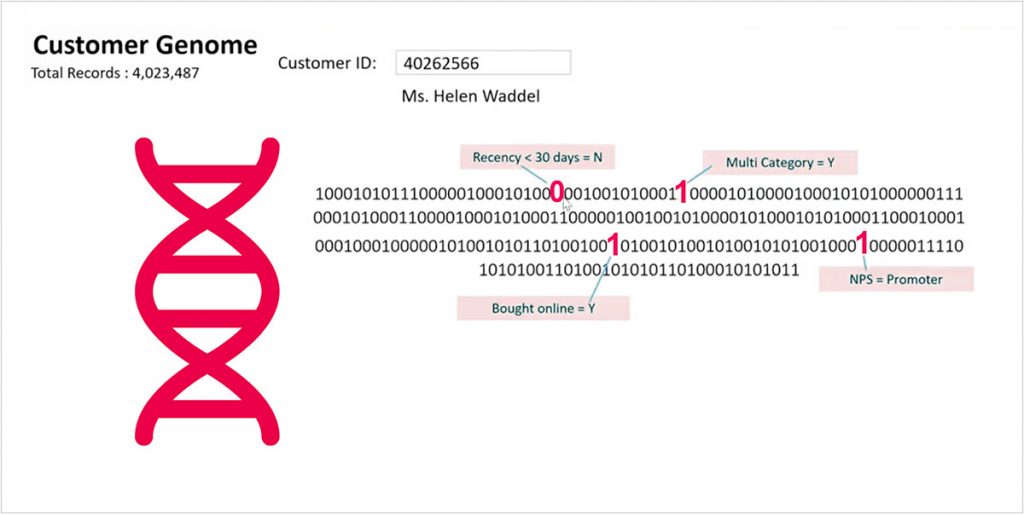
That’s where the customer genome algorithm comes in. Which we are going to talk about in the next section.
Watch this video to understand the cold start problem in Recommender Systems.
The customer genome approach
This approach uses a special algorithm to create a unique string of zeros and ones for each customer based on their data. Then, it matches this string to other customers who are more experienced with the brand to get insights on what might interest the new customer.
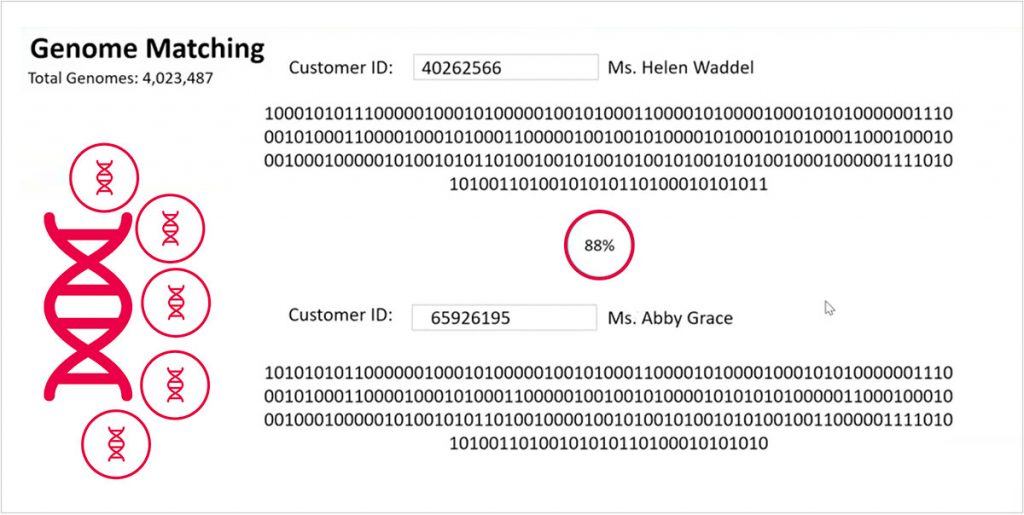
Think of the customer genome as your unique DNA for shopping preferences—the traits determining your choice. It captures every interaction and breaks it into a genetic code representing more than just product names. Even marketing emails have their own DNA, including subject lines, offers, recommended products, and visual and messaging elements.
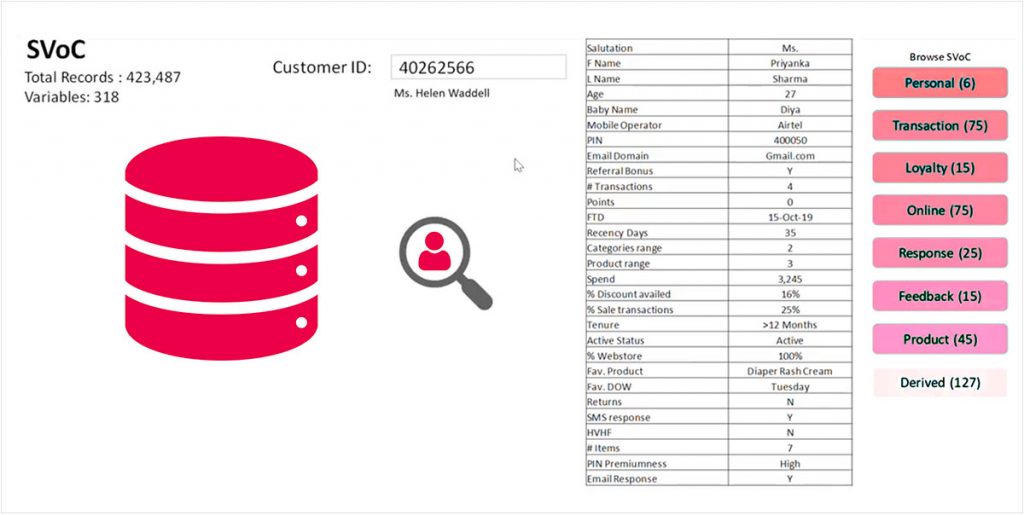
Let’s use apparel as an example to understand how the customer genome approach works. Every time you browse, purchase, or engage with a product, it adds to your genome in various ways. Viewing a product doesn’t mean the same commitment as buying it. When you view an item, it goes on your wish list—you’re showing interest with your time. But when you buy it, you’re saying, ‘Yes, I’m a Zara shopper.’ This principle applies to everything, whether it’s training shoes, health drinks, or groceries. Over time, common attributes emerge, reflecting themes like fitness or specific dietary preferences. This concept holds true across all product categories.
So, in this conceptual example, we have various attributes such as purchase behavior on weekends versus weekdays, buying items on sale or at full price, and many more—around 150 to 200 different variables like these.
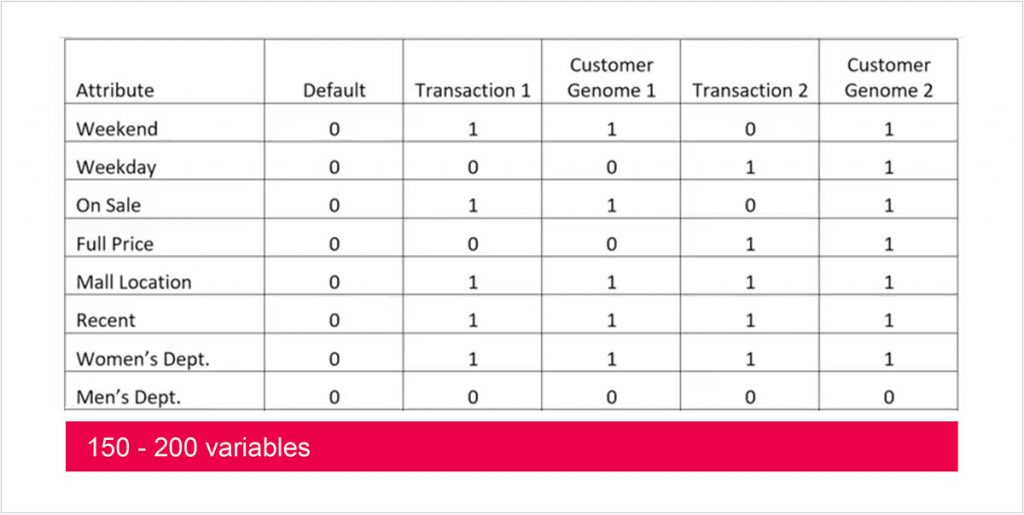
Let’s break down the data from this image. If a customer buys something on a weekend, we mark that specific attribute as ‘1’ for ‘transaction 1’ in our dataset. The same applies to the customer’s overall profile or ‘genome’.
Now, in ‘transaction 2’, if the weekend purchase doesn’t happen again, it still remains marked as ‘1’ since it’s occurred at least once in the customer’s history.
Here’s another scenario from the above image. Suppose a customer didn’t buy anything on a weekday previously, but in the second transaction, they do. Now, this new piece of information is added to their profile. This method helps create detailed customer profiles or ‘genomes’ that become richer over time as more transactions occur.
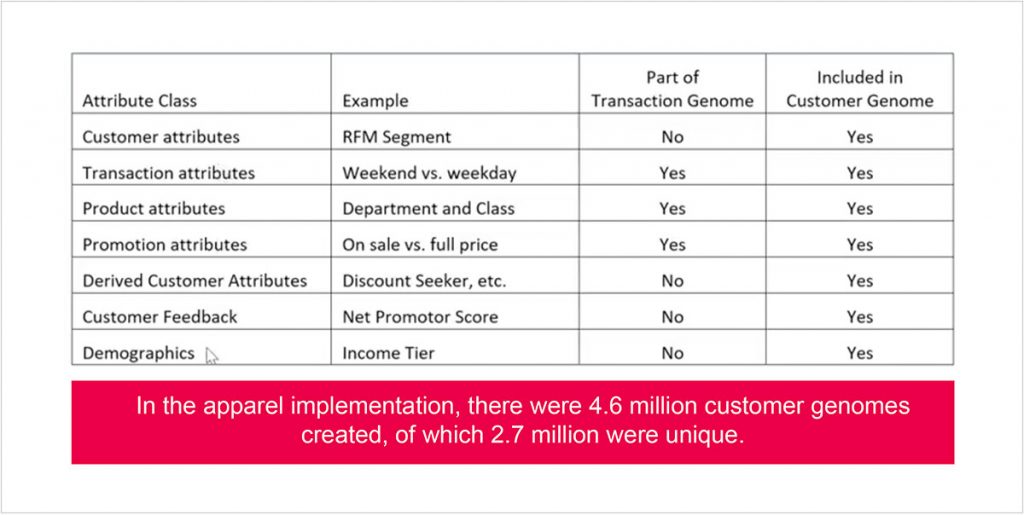
Our platform helps you collect and use various types of attributes—like demographics, transaction details, product preferences, and more—to build these customer profiles. For instance, we can identify customers who are discount seekers based on their purchase behaviors.
In a real-world implementation, such as in retail and consumer services, we applied this approach to 4.6 million customers, resulting in 2.7 million unique customer profiles or ‘genomes’. This means we’re essentially targeting each customer individually with personalized recommendations.
Our platform provides a comprehensive view of each customer, incorporating personal details, transaction history, loyalty program engagement, and other derived variables. These variables are then used to create the detailed customer profiles mentioned earlier.
By matching these profiles to those of more established customers, we can generate highly effective recommendations. Hence, this method has proven very successful in improving customer engagement and satisfaction.
Summary
This fresh approach is a welcome relief for marketers deeply invested in understanding their customers. We often feel overwhelmed by the sheer volume of data and the gaps in our knowledge. Terms like ‘customer 360’ and ‘business intelligence’ can be exhausting when we’re still uncertain about our customers’ behavior.
What sets the genome approach apart is its capability to dive deep into a customer’s preferences, providing not just detailed insights but also a broader understanding. The customer genome approach offers far more meaningful insights than the typical “if you liked these, you’ll also like this” kind of recommendations.
